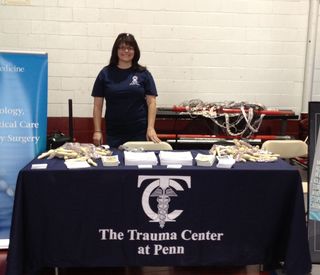 “I want to put trauma doctors out of business.”
“I want to put trauma doctors out of business.”
Rhonda Holmstrom, Trauma Outpatient & Injury Prevention Coordinator, says this with a smile, knowing it’s not a realistic goal, but she –- and other members of the trauma team at the Hospital of the University of Pennsylvania -– are reaching out to the community to help prevent many types of traumatic injury and are hopeful they can at least keep the need for trauma doctors to a minimum.
As a city hospital, HUP has a very busy emergency room. Indeed, last year alone, the ER treated more than 2,500 trauma patients. Most, though, were not victims of car accidents, or even violence like gunshot wounds or stabbings. Instead, many injuries came from falls, most often among patients 65 or older.
According to the Centers for Disease Control website, falls are the leading cause of injury death among adults in this age group. Falls are also the most common cause of nonfatal injuries and hospital admissions for trauma, leading to brain injuries, spinal cord injuries and bone fractures.
The result, Holmstrom notes, is life-changing: “These previously independent people now have an increased morbidity and mortality. Most will not return to their homes.”
Holmstrom is on the warpath to decrease these preventable injuries. She is reaching out to senior centers, community groups, churches, health fairs -– anywhere she can get the word out to this vulnerable population. She’s also planning to target patients of this age group who come to the hospital’s ER because of a fall.
As part of the outreach events she coordinates, she educates seniors about simple ways to make their house safer –- for example, get rid of all throw rugs -- and, thanks to a Penn Medicine CAREs grant*, she can also hand out goodie bags filled with every-day items to make their homes safer: a sensor night light for better visibility at night; bathroom safety grab bars to provide stability while moving in and around bath and shower; and nonslip bathmats to prevent falls while getting in and out of the bath.
Preventing falls is not the only topic in Holmstrom’s arsenal. As she herself notes, “I will go anywhere to talk to anyone about anything that can help prevent trauma.” This outreach includes presentations to pre-prom or pre-graduation high schoolers about the consequences of drinking and driving, and to young teens to teach them how to disagree without becoming violent. She described bringing in a group of “tough” girls who were high risk for police involvement on a tour of the ER, which included the trauma bay, as well as the intensive care unit … and the morgue. “We want to open their eyes, give them the facts of the possible consequences of their choices,” Holmstrom said.
Holmstrom also passionately believes that people -- young and old -– should wear a helmet when biking. Head injuries are the number one injury in biking accidents. “If you don’t wear a helmet, you’re risking traumatic brain injury, which can lead to life-long disability … or even death.”
A second Penn Medicine CAREs grant will help purchase safety equipment to pass out to those who need it. This give-away will include bicycle helmets, reflective leg bands to keep pants from getting caught in the bike chain and make a biker easier to see at night, and reflective strips for the bike.
The Trauma team isn’t the only Penn Medicine group dedicated to preventing debilitating brain injury. Members of Penn’s Center for Brain Injury and Repair also reach out to the community –- most recently, during several events at the Philadelphia Science Festival -- promoting the use of helmets not only for biking but also when skate boarding, skiing, and “any activity where the body is moving really fast and a person can fall and hit his or her head,” said Robin Armstrong, the Center’s Administrative Coordinator.
Armstrong and the CBIR outreach team use ‘fun’ visual aids to help people understand how delicate the brain really is. For example, slowly stretching Silly Putty demonstrates how neurons -– which bring messages from the brain to the spinal cord -- react when a person moves his head in a normal motion. “Like Silly Putty, neurons can accommodate this type of movement.” But, if a person’s head is moving fast and suddenly stopped, such as can happen when falling off a bike, the neuron connection can be broken, much like when Silly Putty is yanked apart quickly.
brain really is. For example, slowly stretching Silly Putty demonstrates how neurons -– which bring messages from the brain to the spinal cord -- react when a person moves his head in a normal motion. “Like Silly Putty, neurons can accommodate this type of movement.” But, if a person’s head is moving fast and suddenly stopped, such as can happen when falling off a bike, the neuron connection can be broken, much like when Silly Putty is yanked apart quickly.
In another demonstration, Armstrong drops two eggs to the floor, one of which is encased in styrofoam. After seeing the unprotected one splatter on the floor -- while the one in styrofoam remains undisturbed -- everyone agrees to wear a helmet.
“We need to show people how easily the brain is damaged, in ways they can understand and, more important, will remember.”
*The Penn Medicine CAREs Program supports and recognizes Penn faculty, student, and/or staff efforts to improve the health of the community and increase volunteerism in community-based programs.
Photo caption: Rhonda Holmstrom at one of the many of her outreach activities to help prevent traumatic injuries.